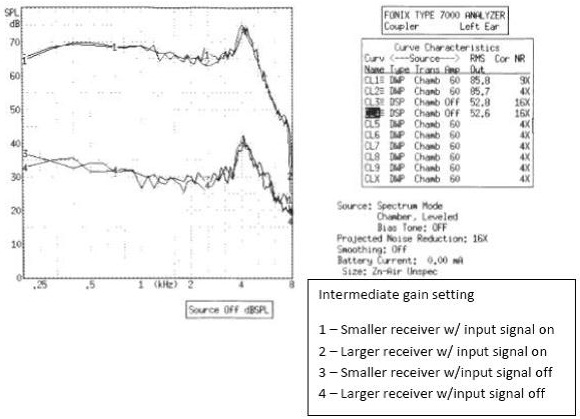Question
I've been fitting a lot of receiver-in-canal (RIC) products, and when I have a patient with good low-frequency hearing, I like to use the smaller gain receiver option because I worry about the larger gain receiver being noisier. Sometimes though, use of the smaller gain receiver makes it difficult to fit prescriptive targets for moderately-severe to severe high frequency hearing loss thresholds. Should I be concerned about larger receivers being noisier?
Answer
You should always be concerned about a noisy hearing aid; however, the receiver is not at fault here. So in short, the answer to your question is no, because larger receivers are not any noisier than smaller receivers (see footnote for clarification of the “larger” and “smaller” descriptor). Let me explain.
First, let's be clear that there are two common definitions of noise with regard to hearing aid operation:
- equivalent input noise (EIN)
- noise floor
Now, it is possible that your patients might complain of a third type of noise—amplified ambient noise. But that is not really “hearing aid noise” per se, so let us return to the two possibilities that I mentioned previously.
In the case of EIN, it is a measure of internal noise generated by microphones and amplifiers in the hearing aid as defined by the ANSI S3.22 electroacoustic standard, so that measure is not applicable when considering the potential noisiness of a receiver. In fact, when you look at electroacoustic analysis of a RIC hearing aid model, the EIN does not change dependent upon the receiver attached to the aid.
A measure of noise floor could conceivably capture any noise generated by a receiver. One way to quantify noise floor is simply to measure the output of the hearing aid in operation with no input signal. To answer this question, we completed some electroacoustic measures using a RIC coupled to a small and large receiver. We were careful to match gain between the different RIC receivers, so we knew that the contribution of the receiver had been isolated.
When the hearing aids, with the different receivers, were programmed to yield the same frequency response output (Figure 1- top two lines), the measures of noise floor for the two hearing aids indeed were the same (Figure 1 - bottom two lines). This was true across three levels of programmed gain – 10 dB, 25 dB, and 32 dB. Figure 1 is of the 25 dB gain level. These results support the fact that a larger receiver does not add inherent noise to the system.
The “catch 22” is that a larger receiver can support a higher maximum possible output (MPO) than the smaller receiver and hence is capable of allowing more gain from the hearing aid system to fit greater hearing loss. As gain is increased by the amplifier, the tradeoff is accompanying amplifier noise, which may be audible for someone with relatively normal hearing in the lower frequencies. In and of itself, the higher MPO does not mean a higher noise floor unless the gain offered by the larger receiver is set in excess of that capable by the smaller receiver. In this case, the higher noise floor is not the receiver's fault; the increased noise floor is simply a byproduct of amplifier noise offered by the greater gain capabilities of the larger receiver.

Figure 1 caption: Data in this figure was collected with use of a Frye Fonix7000 system test box in multicurve mode with two identical model hearing aids using different receivers attached to separate HA1 couplers with the correct manufacturer-specific RIC coupling attachment.
What does all this mean?
In actuality, when fitting RIC hearing aids, the receiver gain size should be determined by the prescribed target for addressing the hearing loss; as a result, the hearing aid will have no more amplifier noise than that needed to obtain the desired target outputs. Use of a larger receiver then would generally be a better choice assuming that the ear canal is large enough to comfortably house the receiver and/or if the fitting is open enough to provide relief from the occlusion effect. Choosing a smaller receiver because it has less noise than a larger receiver is not a credible reason for selecting the smaller one.
* For a given manufacturer, the smaller and larger receivers often are labeled for the peak coupler gain that can be obtained, e.g., 40, 50, etc. Less specific terms such as "LP" or "HP," or words like "standard" and "power" also are used by some manufacturers.
Disclaimer: The opinions expressed in this article are those of the author and do not necessarily represent the official position of the U.S. Department of Veterans Affairs or the United States government.
Acknowledgements: A special thanks to the Christine Brown, BS, a student at the East Tennessee State University/Mountain Home joint AuD residential program and Ginny Alexander, MA, a research audiologist at Mountain Home VAMC for their enthusiasm and organization. Their help in bringing light to this matter is appreciated.

